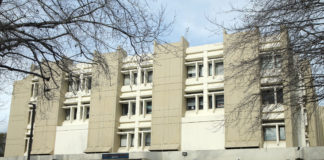
WATSONVILLE—A group of local skateboarders is asking for an apology from the City of Watsonville after a set of skate ramps they purchased were unintentionally destroyed while being removed from the old Ramsay Park skatepark.
Yuridia Alexa Cebada-Martell and other skaters say that on Oct. 22 they purchased the ramps from the City on Public Surplus, an auction website for government entities, and had hoped to scatter them at their homes throughout Watsonville to keep the seven nostalgic structures local.
But when they arrived to pick up the ramps a few days later, Cebada-Martell said, some were badly bent, one was missing and others were warped and had large chunks of their base ripped off.
Watsonville Parks and Community Services Director Nick Calubaquib said the ramps were damaged by Mountain Bikers of Santa Cruz while they were removed to make way for the incoming pump track. The ramps, he said, were decaying from 20 years of wear and tear, and they were also molded into the asphalt, making clean removal that much more difficult.
“They pulled them out the best they could,” he said, “but, obviously, there was some damage… It’s unfortunate that things ended up the way they did.”
Cebada-Martell said she received her money back—she paid $917.49 for the ramps—after a “messy” back and forth with Parks and Community Services staff and Public Surplus. She has not, however, received an apology from the City, and the skateboard community, she said, has not yet recovered from the loss of the park or ramps.
“Having that skatepark taken, it’s heartbreaking,” she said.
Constructed as an outlet for a growing skateboarding population in Watsonville that had few spaces to skate in South County in the early 2000s, the now-demolished skatepark was a gathering place for numerous young people throughout the years—skaters and otherwise.
Cebada-Martell, 25, admitted that she “wasn’t the biggest skater” but said she spent many hours at the park with her friends throughout grade school—she grew up just around the corner from the park.
That group of friends includes Jonathan Fry, who said that the skatepark took on deeper sentimental meaning as generations of skaters passed through—and passed on. He said some of its elements—such as benches and ramps—were dedicated to members of the skateboarding community that had died over the years.
“It was home, pretty much. I spent thousands of hours there,” Fry said.
Fry said he did not believe the City took the proper precautions while removing the ramps or while storing them. He said the ramps were first moved on Oct. 19 to an edge of the old skatepark’s footprint. At that point, he said, they were still intact and in good condition when he visited the park. But two days later, Fry said, they were moved again, and some were stacked on one another, which he says could have caused some of the disfigurement.
When Fry arrived on Oct. 27 to inspect the ramps with two other people, he said they were unrecognizable.
“They were all fine before that day,” said Fry, who provided photos showing the damage had occurred after the second move—not during their removal from the asphalt.
Calubaquib said the City’s auction listing on Public Surplus stated that some of the ramps may not be salvageable. The listing, provided by the City, states that the ramps had some “rust” but that they were in “fair” condition. It also states that “heavy equipment and/or metal cutting tools” would be needed to remove them, and that the City had made no guarantees as to their condition.
Calubaquib admitted the City “probably underestimated how important the skatepark was to a part of our community,” but said that his department could not have done anything differently “that would have resulted in a different outcome.”
Calubaquib said his department’s intent from the beginning was to preserve the ramps.
“From a monetary perspective, it would have made more sense to just recycle them when the time came due to their age and value. We instead chose to auction them thinking that they might be able to be preserved and used by someone else or another group,” he wrote in an email. “In our eyes, the prospect of finding them another home was better than collecting money from recycling them.”
Cebada-Martell said that at this point she does not expect an apology from the City. But she said if the City does decide to extend an olive branch to the skateboarding community, the installation of lights on the remaining skatepark in Ramsay would be a satisfying mea culpa.
Calubaquib said he hopes the new pump track will serve as a peace offering for those reeling from the loss of the old skatepark.
A pump track is a circuit of hills, banked turns and features designed to be ridden completely by riders “pumping”—generating momentum by up and down body movements, instead of pedaling or pushing. Although bikes are more commonly used to maneuver through pump tracks, the track under construction at Ramsay will be made with an asphalt surface so that people on skates and skateboards can also weave their way through the course.
“It’s going to open up another opportunity for skaters,” he said. “Not just bikers.”











